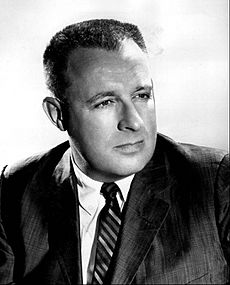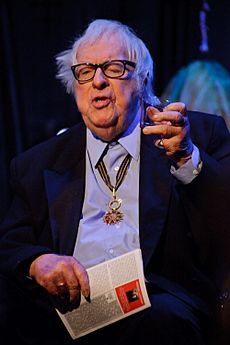Ray Bradbury facts for kids
Quick facts for kids
Ray Bradbury
|
|
|---|---|
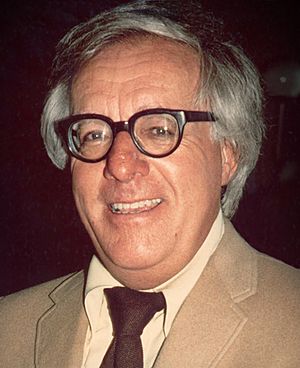
Bradbury in 1975
|
|
| Born | Ray Douglas Bradbury August 22, 1920 Waukegan, Illinois, U.S. |
| Died | June 5, 2012 (aged 91) Los Angeles, California, U.S. |
| Resting place | Westwood Memorial Park |
| Occupation | Writer |
| Education | Los Angeles High School |
| Period | 1938–2012 |
| Genre |
|
| Notable works |
|
| Notable awards |
|
| Spouse |
Marguerite McClure
(m. 1947; |
| Children | 4 |
| Signature | |
Ray Douglas Bradbury (born August 22, 1920 – died June 5, 2012) was a famous American writer and screenwriter. He is known as one of the most celebrated American authors of the 20th century. Bradbury wrote many different kinds of stories, including fantasy, science fiction, horror, and mystery.
Many people know Bradbury best for his novel Fahrenheit 451 (1953). He also wrote popular short story collections like The Martian Chronicles (1950) and The Illustrated Man (1951). While much of his work is speculative fiction (stories about things that could happen in the future or in other worlds), he also wrote other types of books. These include Dandelion Wine (1957), which is about growing up, and Green Shadows, White Whale (1992), which is like a fictional diary. He also helped write movies and TV shows, such as Moby Dick. Many of his stories were turned into films, TV shows, and even comic books.
The New York Times newspaper said that Bradbury was "the writer most responsible for bringing modern science fiction into the literary mainstream." This means he helped make science fiction popular and respected in the world of literature.
Contents
- When and where was Ray Bradbury born?
- What inspired Ray Bradbury's writing?
- How did Ray Bradbury start his career?
- What was Ray Bradbury's writing style like?
- How did Ray Bradbury influence culture?
- How were Ray Bradbury's works adapted?
- What was Ray Bradbury's personal life like?
- When did Ray Bradbury die?
- What awards and honors did Ray Bradbury receive?
- Ray Bradbury Quotes
- See also
When and where was Ray Bradbury born?
Ray Bradbury was born in Waukegan, Illinois, in the United States. His mother, Esther Bradbury, was from Sweden. His father, Leonard Bradbury, worked with power and telephone lines. Ray was given the middle name "Douglas" after a famous actor named Douglas Fairbanks.
Ray grew up surrounded by his family in Waukegan. His aunt would read him short stories when he was a child. These early years were very important for him as a writer. In his stories, Waukegan often became a fictional place he called "Green Town."
His family lived in Tucson, Arizona, for a couple of years when he was younger. They moved there because his father was looking for work. Each time, they returned to Waukegan. Finally, in 1934, when Ray was 14, they moved to Los Angeles for good. They arrived with very little money, but his father found a job, and they stayed in Hollywood.
Bradbury went to Los Angeles High School. He was very active in the drama club there. He loved to roller-skate around Hollywood, hoping to meet famous people. He met special-effects pioneer Ray Harryhausen and radio star George Burns. When he was 14, Ray sold a joke to George Burns for his radio show, which was his first time getting paid for his writing.
What inspired Ray Bradbury's writing?
Books and reading
From a young age, Bradbury loved to read and write. He knew early on that he wanted to work in the arts. He started writing his own stories when he was 12 years old, sometimes even writing on butcher paper.
He spent a lot of time at the Carnegie Library in Waukegan. There, he read books by authors like H. G. Wells, Jules Verne, and Edgar Allan Poe. He said he tried to write like Poe until he was about 18. He also loved the stories of Edgar Rice Burroughs, who created Tarzan of the Apes. Burroughs's John Carter of Mars series impressed him so much that he wrote his own sequel when he was 12. Young Ray also enjoyed drawing and even drew his own Tarzan comic strips. He would listen to the radio show Chandu the Magician and then write down the whole script from memory.
As a teenager in Beverly Hills, he often visited his friend and mentor, science fiction writer Bob Olsen. They would share ideas and stay in touch. When he was 16, Bradbury found a flyer for the Los Angeles Science Fiction Society in a bookstore. He was excited to find other people who liked science fiction and joined their meetings.
Bradbury said that H. G. Wells and Jules Verne were his main inspirations for science fiction. He felt a connection with Verne, saying that Verne believed humans are in a strange world but can succeed by being good. Bradbury also read a lot of poetry and other types of literature. He said that meeting writer Robert Heinlein, who wrote "humanistic science fiction," made him brave enough to write about human feelings instead of just machines.
Hollywood and movies
Ray's family lived close to a movie theater in Los Angeles. He learned how to sneak in and watched movie previews almost every week. He roller-skated everywhere, trying to get autographs from movie stars. He met famous people like Norma Shearer, Laurel and Hardy, and Ronald Colman. Sometimes, he would spend all day outside movie studios or at the Brown Derby restaurant, watching stars like Cary Grant and Marlene Dietrich.
Bradbury once told a story about meeting Sergei Bondarchuk, a famous Russian film director. At an awards ceremony in Hollywood, Bondarchuk recognized Bradbury and was very excited to see him. This surprised many famous Hollywood directors who didn't know who Bradbury was.
How did Ray Bradbury start his career?
Bradbury's very first published story was "Hollerbochen's Dilemma" in a fan magazine called Imagination! in 1938. In 1939, a friend helped him get money to go to the first World Science Fiction Convention in New York City. This friend also helped fund Bradbury's own fan magazine, Futuria Fantasia. Bradbury wrote most of the stories for its four issues.
Ray Bradbury was not allowed to join the military during World War II because of his poor eyesight. This meant he was free to focus on writing. He had been inspired by science fiction heroes like Flash Gordon and Buck Rogers. He started publishing his science fiction stories in fan magazines in 1938. He was invited to the Los Angeles Science Fiction Society, where he met other writers like Robert A. Heinlein.
In 1939, Bradbury joined a theater group for two years, where he wrote and acted in plays. He later said these plays were "so incredibly bad" that he stopped writing plays for 20 years. His first story that he was paid for, "Pendulum," was published in 1941, and he earned $15.
Bradbury sold his first story written by himself, "The Lake," for $13.75 when he was 22. By the time he was 24, he was a full-time writer. His first collection of short stories, Dark Carnival, was published in 1947. A reviewer for the New York Herald Tribune said Bradbury was "suitable for general consumption" and predicted he would become a great writer.
After a story was rejected by one magazine, Bradbury sent "Homecoming" to Mademoiselle. A young editor named Truman Capote found it and helped get it published. "Homecoming" was even chosen for the O. Henry Award Stories of 1947.
Bradbury wrote his famous novel Fahrenheit 451 in a study room at UCLA's library. He rented a typewriter for ten cents every half-hour. The first version of the story, called The Fireman, was about 25,000 words long. It later grew to about 50,000 words and became Fahrenheit 451. The total cost for using the typewriters was $9.80.
He also met a British writer named Christopher Isherwood in a bookstore. This meeting helped Bradbury get his book The Martian Chronicles into the hands of a respected critic, who then wrote a great review.
What was Ray Bradbury's writing style like?
Bradbury said he wrote every day because of two important moments. The first was when he was three years old and his mother took him to see the silent film The Hunchback of Notre Dame. The second was in 1932, when a carnival performer called Mr. Electrico touched him with an electrified sword and shouted, "Live forever!" Bradbury felt that something "strange and wonderful" had happened. He said, "I began to write, full-time. I have written every single day of my life since that day." Before he found writing, Bradbury loved doing magic and said he would have become a magician.
Bradbury said he was influenced by many writers and poets. He learned from John Steinbeck how to write about things clearly while still showing deep understanding. He studied Eudora Welty for her amazing ability to create a feeling, character, and movement in just one sentence. His favorite writers growing up included Katherine Anne Porter and Edith Wharton.
Bradbury was sometimes called a "Midwest surrealist" and often a science fiction writer. He described science fiction as "the art of the possible." However, he didn't always like being called a science fiction writer. He said:
First of all, I don't write science fiction. I've only done one science fiction book and that's Fahrenheit 451, based on reality. Science fiction is a depiction of the real. Fantasy is a depiction of the unreal. So Martian Chronicles is not science fiction, it's fantasy. It couldn't happen, you see? That's the reason it's going to be around a long time—because it's a Greek myth, and myths have staying power.
Bradbury remembered a moment when he truly found his own writing voice. It was when he wrote a short story about his first experience with death. As a boy, he met a girl at a lake, and she went into the water and never came back. Years later, when he wrote about it, he cried. He realized he was no longer just copying other writers but connecting with his own feelings.
When asked about the beautiful way he wrote, he said, "From reading so much poetry every day of my life. My favorite writers have been those who've said things well." He also said, "If you're reluctant to weep, you won't live a full and complete life."
In high school, Bradbury was part of the poetry and drama clubs. He wanted to be an actor but became serious about writing as he got older. He graduated from Los Angeles High School, where his teachers helped him develop his writing talent. He did not go to college. Instead, he sold newspapers. He said, "Libraries raised me. I don't believe in colleges and universities. I believe in libraries because most students don't have any money."
He didn't think science was the most important part of his writing. He used science as a way to comment on society and tell stories with deeper meanings. He said his ideas for stories would "run up and bite me in the leg—I respond by writing them down."
What is "Green Town"?
"Green Town" is a fictional place Bradbury created, based on his hometown of Waukegan, Illinois. It represents safety and home. He often used it as a peaceful background for stories that involved fantasy or danger. It is the setting for his books Dandelion Wine, Something Wicked This Way Comes, and Farewell Summer. Many of his short stories also take place there. In Green Town, strange things happen, like his uncle growing wings, or traveling carnivals having magical powers. His grandparents even host famous writer Charles Dickens. In Summer Morning, Summer Night, a collection of stories about Green Town, Bradbury looked back at the small-town American life that was disappearing.
How did Ray Bradbury influence culture?
Bradbury wrote many essays about culture and art. He used his stories to explore and criticize society. For example, he noted that Fahrenheit 451 showed how media could make people feel alone:
In writing the short novel Fahrenheit 451 I thought I was describing a world that might evolve in four or five decades. But only a few weeks ago, in Beverly Hills one night, a husband and wife passed me, walking their dog. I stood staring after them, absolutely stunned. The woman held in one hand a small cigarette-package-sized radio, its antenna quivering. From this sprang tiny copper wires which ended in a dainty cone plugged into her right ear. There she was, oblivious to man and dog, listening to far winds and whispers and soap opera cries, sleep walking, helped up and down curbs by a husband who might just as well not have been there. This was not fiction.
Bradbury also said that Fahrenheit 451 was a criticism of "political correctness" later on. He believed that political correctness could lead to people trying to control what others think and say.
In 1982, he wrote, "People ask me to predict the Future, when all I want to do is prevent it." This shows his goal was to warn people about possible futures, not just guess what would happen.
In 1956, Bradbury appeared on the TV quiz show You Bet Your Life with Groucho Marx. He talked about his books, including his short story "The Veldt."
Bradbury was a consultant for the American Pavilion at the 1964 New York World's Fair. He also worked on the original exhibit for Epcot's Spaceship Earth at Walt Disney World. In the late 1980s and early 1990s, he hosted The Ray Bradbury Theater, a TV show based on his short stories.
Bradbury strongly supported public libraries. He helped raise money to keep several libraries in California from closing. He often said that "libraries raised me" because he learned so much from them instead of going to college. His views on modern technology changed over time. In 1985, he said he saw "nothing but good coming from computers." But in 2010, he said, "We have too many cellphones. We've got too many internets. We have got to get rid of those machines." When the rights for Fahrenheit 451 were renewed in 2011, Bradbury allowed it to be published as an e-book, but only if libraries could lend it out digitally to anyone.
Many comic book writers, especially from EC Comics, adapted Bradbury's stories. At first, they copied his stories without permission. But after Bradbury sent a polite letter, they started paying him and properly licensing his work. His stories appeared in comics like Tales from the Crypt and Weird Science.
Bradbury loved theater throughout his life. He led the Pandemonium Theatre Company in Los Angeles for many years.
Two documentaries feature Bradbury: Charles Beaumont: The Life of Twilight Zone's Magic Man and The AckerMonster Chronicles!.
A bookstore in California called "Fahrenheit 451 Books" was named after his famous novel. Bradbury and his favorite artist, Joseph Mugnaini, even attended the opening of an addition to the store.
How were Ray Bradbury's works adapted?
From 1950 to 1954, 31 of Bradbury's stories were adapted for EC Comics. Many of these were later collected into paperbacks like The Autumn People (1965).
In the early 1950s, Bradbury's stories were also adapted for several TV shows. These included Tales of Tomorrow and Alfred Hitchcock Presents. Some stories were also adapted for radio dramas, like Dimension X.
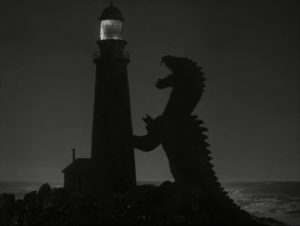
Producer William Alland brought Bradbury's stories to movie theaters in 1953 with It Came from Outer Space. Soon after, The Beast from 20,000 Fathoms (1953) was released. This movie had a scene based on Bradbury's story "The Fog Horn," about a sea monster that mistakes a fog horn for another monster's call. Ray Bradbury's close friend, Ray Harryhausen, created the stop-motion animation for the creature. Over the next 50 years, more than 35 movies and TV shows were based on Bradbury's stories.
In 1953, director John Huston hired Bradbury to help write the movie script for Moby Dick. Bradbury later wrote a book about his experiences making the film called Green Shadows, White Whale.
Bradbury's short story "I Sing the Body Electric" was adapted for the 100th episode of The Twilight Zone in 1962.
Bradbury and director Charles Rome Smith started the Pandemonium Theatre Company in 1964. Their first show, The World of Ray Bradbury, included adaptations of his short stories like "The Pedestrian" and "The Veldt."
The movie Fahrenheit 451 (1966) was based on Bradbury's novel and directed by François Truffaut.
In 1969, The Illustrated Man was made into a movie starring Rod Steiger. It included a prologue and three short stories from the book.
The Martian Chronicles became a three-part TV miniseries in 1980. Bradbury himself found the miniseries "just boring."
The 1982 TV movie The Electric Grandmother was based on Bradbury's short story "I Sing the Body Electric."
The 1983 horror film Something Wicked This Way Comes was based on Bradbury's novel of the same name.
In 1984, a series of 13 audio adaptations of Bradbury's stories called "Bradbury 13" was produced. It featured stories like "The Veldt" and "A Sound of Thunder". Ray Bradbury himself provided the opening voiceover. The series won several awards.
From 1985 to 1992, Bradbury hosted a TV show called The Ray Bradbury Theater. He adapted 65 of his own stories for the show. Each episode started with Bradbury in his office, talking about how his memories inspired his stories.
Bradbury's stories were also very popular in the USSR. Several of his works were adapted into episodes of the Soviet TV series This Fantastic World. There were also cartoon adaptations of his stories like "There Will Come Soft Rains" and "Here There Be Tygers".
Bradbury wrote and narrated the 1993 animated TV version of The Halloween Tree, based on his 1972 novel.
The 1998 film The Wonderful Ice Cream Suit was written by Bradbury. It was based on his story "The Magic White Suit."
In 2005, the movie A Sound of Thunder was released, based on his short story. The movie The Butterfly Effect also uses a similar idea to "A Sound of Thunder."
In 2005, Bradbury was upset with filmmaker Michael Moore for using the title Fahrenheit 9/11 for his documentary. Bradbury felt it was too similar to his own book Fahrenheit 451. He asked Moore to change the name, but it was too late.
In 2008, the film Ray Bradbury's Chrysalis was made, based on his short story of the same name. It won an award at a film festival.
In 2010, The Martian Chronicles was adapted for radio.
What was Ray Bradbury's personal life like?
Ray Bradbury lived at his parents' home until he was 27 and got married. He married Marguerite McClure (Maggie) in 1947, and they were together until her death in 2003. Maggie was the only woman he ever dated. They had four daughters: Susan, Ramona, Bettina, and Alexandra. Bradbury never learned to drive a car. He always used public transportation or rode his bicycle.
He was raised Baptist by his parents, but as an adult, he described himself as a "delicatessen religionist." This meant he took ideas from many different faiths and didn't fit into one category. He felt that his writing career was "a God-given thing."
Bradbury was good friends with Charles Addams, the artist who created The Addams Family. Addams illustrated Bradbury's first story about the Elliott family, who were similar to the Addams Family. They planned to work on a bigger project together, but it never happened. In 2001, Bradbury published all his Elliott family stories in one book called From the Dust Returned, with an Addams cover.
Another close friend was animator Ray Harryhausen. Harryhausen was the best man at Bradbury's wedding. They met when they were both 18 and shared a love for science fiction and movies like King Kong. Their friendship lasted over 70 years.
Late in his life, Bradbury continued to write despite illnesses and the deaths of many friends. He was very sad when Star Trek creator Gene Roddenberry, a close friend for many years, passed away. Roddenberry had asked Bradbury to write for Star Trek, but Bradbury never did, saying he couldn't adapt other people's ideas well.
Bradbury had a stroke in 1999, which meant he needed a wheelchair sometimes. But he kept writing. He even wrote an essay for The New Yorker about his writing inspiration just a week before he died. He regularly attended science fiction conventions until 2009, when he retired.
Bradbury chose to be buried at Westwood Village Memorial Park Cemetery in Los Angeles. His headstone reads: "Author of Fahrenheit 451." In 2015, the house where Bradbury lived and wrote for 50 years in Los Angeles was torn down by its new owner.
When did Ray Bradbury die?
Ray Bradbury died in Los Angeles, California, on June 5, 2012. He was 91 years old and had been ill for a long time. He left his personal library to the Waukegan Public Library, which was where he spent many important hours reading as a child.
The Los Angeles Times newspaper said he could write beautifully about imaginary worlds. His grandson, Danny Karapetian, said Bradbury's works "influenced so many artists, writers, teachers, scientists." The Washington Post pointed out that Bradbury had imagined many modern technologies long ago. These included banking ATMs and earbuds in Fahrenheit 451, and the idea of artificial intelligence in I Sing the Body Electric.
On June 6, 2012, President Barack Obama released a statement about Bradbury's death. He said that Bradbury's stories "reshaped our culture and expanded our world." He added that Bradbury "will continue to inspire many more generations with his writing."
Many fans and other writers paid tribute to Bradbury. Filmmaker Steven Spielberg called Bradbury "[his] muse for the better part of [his] sci-fi career." Writer Neil Gaiman said the world would be "diminished" without him. Author Stephen King said, "Ray Bradbury wrote three great novels and three hundred great stories."
What awards and honors did Ray Bradbury receive?
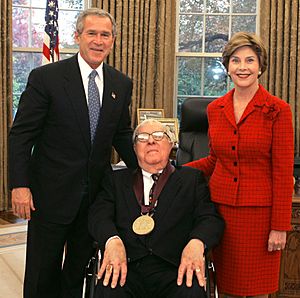
The Ray Bradbury Award for excellence in screenwriting is sometimes given by the Science Fiction and Fantasy Writers of America. Starting in 2010, the Ray Bradbury Award for Outstanding Dramatic Presentation is given every year.
- In 1971, a crater on the Moon was named Dandelion by astronauts. This was in honor of Bradbury's 1957 novel Dandelion Wine.
- In 1979, he received an honorary Doctor of Letters degree from Whittier College.
- In 1984, he received the Prometheus Award for Fahrenheit 451.
- In 1986, Ray Bradbury was a special guest at the 44th World Science Fiction Convention.
- Ray Bradbury Park was opened in Waukegan, Illinois, in 1990. Bradbury was there for the ceremony. The park has places described in Dandelion Wine.
- An asteroid discovered in 1992 was named "9766 Bradbury" in his honor.
- In 1994, he won an Emmy Award for the screenplay The Halloween Tree.
- In 2000, he received the Medal for Distinguished Contribution to American Letters.
- On April 1, 2002, Bradbury received a star on the Hollywood Walk of Fame for his work in movies.
- In 2003, he received an honorary doctorate from Woodbury University.
- On November 17, 2004, President George W. Bush and First Lady Laura Bush gave Bradbury the National Medal of Arts.
- He received a World Fantasy Award for Life Achievement in 1977. He was also named Gandalf Grand Master of Fantasy in 1980.
- In 2005, he received an honorary Doctor of Laws degree from the National University of Ireland, Galway.
- On April 16, 2007, Bradbury received a special award from the Pulitzer Prize jury. This was for his "distinguished, prolific, and deeply influential career."
- In 2007, the French government made Bradbury a Commandeur (Commander) of the Ordre des Arts et des Lettres.
- In 2012, the NASA Curiosity rover landing site on Mars was named "Bradbury Landing" in his honor.
- On December 6, 2012, a street corner in Los Angeles was named "Ray Bradbury Square."
- On February 24, 2013, Bradbury was honored at the 85th Academy Awards during their "In Memoriam" segment.
Ray Bradbury Quotes
- "The first thing you learn in life is you’re a fool. The last thing you learn in life is you’re the same fool."
- "Joy is the grace we say to God."
- "People ask me to predict the future, when all I want to do is prevent it. Better yet, build it."
- "You can make yourself happy or miserable - it's the same amount of effort."
- "Action is hope. There is no hope without action."
- "Stuff your eyes with wonder . . . live as if you'd drop dead in ten seconds."
- "My job is to help you fall in love."
- "Sometimes I think I understand everything. Then I regain consciousness"
See also
 In Spanish: Ray Bradbury para niños
In Spanish: Ray Bradbury para niños



